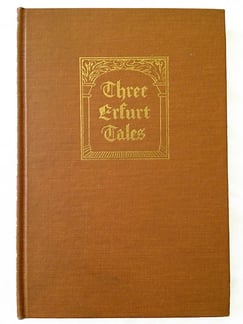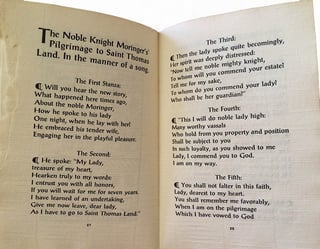In 1958, Henry Morris, inspired by piece of medieval paper he'd recently acquired and a new hobby of paper making, founded Bird & Bull Press. Bird & Bull Press published over seventy-five beautiful books, each printed on paper handmade by Morris himself or carefully selected and imported. Bird & Bull publications were printed by letterpress from metal type, creating books that not only serve as a lovely example of the skill and artistry that goes into bookmaking, typography, and paper making, but as a means of preserving a history and tradition that otherwise may have been lost.
With titles focusing on the history of printing and paper making, books created by Bird & Bull practice what they preach. While Morris officially retired in 2013 and Bird & Bull ceased publication, the lasting impression his press made in the craft has been lauded and widely recognized. In 2007, Morris was awarded the American Printing History Association Individual Award for Distinguished Achievement in Printing History.
Books from Bird & Bull Press are now often collected, not just for the rarity of their limited releases but for the artistry and fine subject matter of each title. Here are just a few examples of the amazing work Bird & Bull produced in its illustrious history:
Papyrus, or the Craft of Paper by Jean Imberdis
 This 1961 book was the second title to be produced by Morris. The first, a book of 19th century recipes, was crafted simply to find a good project for which to utilize a particularly fine paper. Papyrus, however, was the first true book to be printed by Bird & Bull Press, and is the first English translation of a 17th century text by Jesuit priest Jean Imberdis detailing the art of paper making. The value of this book lies not just in its fine printing, but in the historical preservation of the history and tradition of paper making in 1600s France.
This 1961 book was the second title to be produced by Morris. The first, a book of 19th century recipes, was crafted simply to find a good project for which to utilize a particularly fine paper. Papyrus, however, was the first true book to be printed by Bird & Bull Press, and is the first English translation of a 17th century text by Jesuit priest Jean Imberdis detailing the art of paper making. The value of this book lies not just in its fine printing, but in the historical preservation of the history and tradition of paper making in 1600s France.
Three Erfurt Tales
The third of Bird & Bull's printings was recommended to Morris by collector Lessing J. Rosenwald, who offered up the original German text from his own collection. A set of three morality tales, the book had never before appeared in English. Notably, this edition includes reproductions of the original 15th century woodcuts. This collaboration between Morris and Rosenwald led to a lifelong friendship between the two men that positively influenced the trajectory of the press as it grew.
The World's Worst Marbled Papers: Being a Collection of Ten Contemporary San Serriffean Marbled Papers Showing the Lowest Level of Technique, the Worst Combinations of Colors, and the Most Inferior Execution Known Since the Dawn of the Art of Marbling
 Published in 1978, this humorous and satirical sample of terrible marbled papers with an introduction and critical commentary on each was inspired by a batch of unattractive and otherwise unusable papers Morris purchased in bulk. Unhappy with the quality, this book was written to make use of and laugh about the poor nature of the paper, which not coincidentally, the company soon after ceased to produce. Morris wrote the book under the pseudonym of Theodore Bachaus to avoid backlash and claimed the papers to be examples of paper craft of the fictional island of Sans Serriffe. He even went so far as to publish the book under the fictitious name of Sans Serriffe Press.
Published in 1978, this humorous and satirical sample of terrible marbled papers with an introduction and critical commentary on each was inspired by a batch of unattractive and otherwise unusable papers Morris purchased in bulk. Unhappy with the quality, this book was written to make use of and laugh about the poor nature of the paper, which not coincidentally, the company soon after ceased to produce. Morris wrote the book under the pseudonym of Theodore Bachaus to avoid backlash and claimed the papers to be examples of paper craft of the fictional island of Sans Serriffe. He even went so far as to publish the book under the fictitious name of Sans Serriffe Press.
Thirty Years of Bird & Bull: A Bibliography, 1958-1988
This 1988 production is more than simply a catalog of every printed work from Bird & Bull. Morris provided commentary on why each title was selected, details on the making of the paper, and a description of the process used to see each particular book to publication. Notably, this is the last of Bird & Bull's books printed on paper made by Morris. After this, he ceased using his own paper for published works, instead focusing on the art of printing and publishing each.









